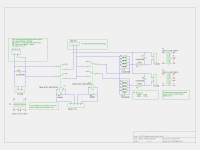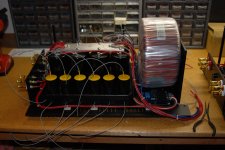Started to think about the soft start for my new amp.
Resistors in the primary are not fail-safe.
Thermistor is better but still not ideal if the amp is turned off and then back on while the thermistor is still warm. And hot components are undesirable.
So, any one considered to switch a mains rated capacitor to limit the inrush current?
Capacitor start induction motors have similar requirements and are extremely reliable. The capacitors would be well suited and are readily available.
Safer, cooler, more reliable - any one tried this or seen it?
The second question is about how much the inrush current is determined by the transformer inductance, versus the capacitor bank load. Self mentions this but with no actual data. Cordell also.
Anyone have the data or do I have to calculate it myself?
David
Resistors in the primary are not fail-safe.
Thermistor is better but still not ideal if the amp is turned off and then back on while the thermistor is still warm. And hot components are undesirable.
So, any one considered to switch a mains rated capacitor to limit the inrush current?
Capacitor start induction motors have similar requirements and are extremely reliable. The capacitors would be well suited and are readily available.
Safer, cooler, more reliable - any one tried this or seen it?
The second question is about how much the inrush current is determined by the transformer inductance, versus the capacitor bank load. Self mentions this but with no actual data. Cordell also.
Anyone have the data or do I have to calculate it myself?
David
Started to think about the soft start for my new amp.
Resistors in the primary are not fail-safe.
David
Putting a few resistors in a "series-parallel" (N-parallel copies of 2-in-series) should cover the major open/short resistor failure modes. Several resistors are typically used in "good" designs to distribute the heat.
My Krell KSA250 amps use just one in-rush resistor, and place it right next to an electrolitic capacitor.... the resistor's heat quickly destroys the capacitor. A "not good" design.
Putting a few resistors in a "series-parallel" (N-parallel copies of 2-in-series) should cover the major open/short resistor failure modes...
What I had in mind was that if the soft start relay fails to switch properly then the resistors are practically never able to cope with continuous operation.
They are inevitably specified for the normal, tiny duty cycle of just an occasional in-rush.
My Krell KSA250 amps use just one in-rush resistor, and place it right next to an electrolitic capacitor.... the resistor's heat quickly destroys the capacitor. A "not good" design.
It seems their reputation is over-hyped if that is the quality of the product, but I will skip that and just say it reinforces my point that heat is undesirable.
Best wishes
David
Check out Jeff Macaulay's softstart feature in his 1991 Moscode amp.
A quick look at the site doesn't show any schematics.
Can you post a better link?
Best wishes
David
I was going to build based on diyaudiostore pcb, but when I find the item Audio SoftStart Kit which is available in local store for $4. Tested on my_reff and it's working fine. What i like from this design is that it's using 12V dual relay, load indicator,MF resistor. Then I upgrade 2 elco with panasonic and change relays with omron, where the original marked as HUIKE.
Having custom design will give more satisfaction, but at the end I think that the most important device is a good relay where other parts will be unusable after the device fully working.
Having custom design will give more satisfaction, but at the end I think that the most important device is a good relay where other parts will be unusable after the device fully working.
So, any one considered to switch a mains rated capacitor to limit the inrush current?
At switch on, the capacitor is discharged and looks like a short circuit, defeating the purpose.
At switch on, the capacitor is discharged and looks like a short circuit, defeating the purpose.
Induction motor start capacitors can be obtained around 3uF. Calculate the reactance at 50 Hz, it should limit the current to under an amp.
It does interact with the transformer inductance, so this is not entirely simple.
Best wishes
David
After about 100 ~ 250 milliseconds you have to short circuit the cap - if they are full loaded with mains voltage the cap would be able to provide strong current for very short time - not good for your relay contacts.
My inrush current design for the 2stageEF is using 4 x 5W wirewound resistors in parallel (using: Vitrohm 208-8; even if 2 of them fail, the circuit is working properly). The microcontroller board delays re-powering long enough to keep the resistors cool - hence increasing the lifetime.
BR, Toni
P.S.: forgive the bad picture quality - it's an old, but good working and often used schematic ...
My inrush current design for the 2stageEF is using 4 x 5W wirewound resistors in parallel (using: Vitrohm 208-8; even if 2 of them fail, the circuit is working properly). The microcontroller board delays re-powering long enough to keep the resistors cool - hence increasing the lifetime.
BR, Toni
P.S.: forgive the bad picture quality - it's an old, but good working and often used schematic ...
Attachments
Thermistor is better but still not ideal if the amp is turned off and then back on while the thermistor is still warm.
I'm still using the 20 year old one out of a genesis amp
(10A). You would really have to flick the switch fast - only stays warm for a couple hundred milliseconds.
This would do ...
http://www.farnell.com/datasheets/87339.pdf
I use this 20A monster , can barely feel any heat at all with a 1KVA toroid.
OS
With a 500VA toroid i use a 50R/5W ceramic resistor
wich is shunted after a few seconds by a relay feeded
by the transformer secondary through a basic temporisation,
it proved reliable through years of daily uses.
Out of fear i switched on/off the amp many times consecutively
to check if the resistor was not heating too much....
wich is shunted after a few seconds by a relay feeded
by the transformer secondary through a basic temporisation,
it proved reliable through years of daily uses.
Out of fear i switched on/off the amp many times consecutively
to check if the resistor was not heating too much....
After about 100 ~ 250 milliseconds you have to short circuit the cap - if they are full loaded with mains... - not good for your relay contacts.
The relay is connected to mains anyway, possibly at the peak of the waveform.
The mains can supply very substantial current.
The capacitor holds about 1/10 of a joule, you think it makes a difference?
Could always use a zero cross detector solid state relay, maybe a nice idea anyway.
Best wishes
David
Last edited:
I'm still using the 20 year old one...[thermistor]
With a 500VA toroid i use a 50R/5W ceramic resistor
...
These work.
I just like the idea of less heat and better fail safety at the same time.
And the capacitors are actually specified for this use, don't have to worry like Wahab about whether the resistors will handle a load they are probably not specified for.
Best wishes
David
Last edited:
Dear David,The relay is connected to mains anyway, possibly at the peak of the waveform.
The mains can supply very substantial current.
The capacitor holds about 1/10 of a joule, you think it makes a difference?
Could always use a zero cross detector solid state relay, maybe a nice idea anyway.
Best wishes
David
you would need a big capacitor for startup. Think of secondary side - the big eletrolytics which are initial a short circuit ...
The above resistor based circuit doesn't dissipate much heat.
For a single power on cycle and a single connection time of about 200ms they get a little bit warm. The values of the resistors in series with the toroid are calculated that your power supply get's quickly to the operating voltage.
Using a zero cross detector solid state relay maybe is also an option which I have thought about some months ago. Have already bought a bunch of S216S02 (16A/250VAC) for testing. But don't think that zero crossing and shorting the cap would work.
Always wear safety glasses!
BR, Toni
Maximum inrush current for a large transformer core occurs when it is switched on at the zero crossing point. Lowest inrush current occurs when power is applied at the peak of the cycle... counter intuitive but that's the way it is.
you are right for standard L but IMHO the inrush current lasts longer as one cycle:Maximum inrush current for a large transformer core occurs when it is switched on at the zero crossing point. Lowest inrush current occurs when power is applied at the peak of the cycle... counter intuitive but that's the way it is.
File:Einschaltstrom-3.png - Wikimedia Commons
BR, Toni
I use a triac in series with 4 ea CL40, which in turn is shorted by 4 relay contacts in parallel thats closing after about 5 seconds. Have used this soft start circuit for the past 15 years and have not had one fail yet of several 100 out there. In my big power amps I have a 4KVA transformer and about 500000uf of capacitance, they have no issues here either.
Best of luck
Peter
Best of luck
Peter
Attachments
SS ckt to offer
Hi,
I have been working on this SS ckt for a bit. Yet to fab. I have added a small transformer for a aux supply, ie. MCU.
I have supplied the sch & layout for a review. It is basically based on a Pioneer SX-1250 and the LME498xx PS app note.
If of any use, let me know & I can provide more info.
Rick
Hi,
I have been working on this SS ckt for a bit. Yet to fab. I have added a small transformer for a aux supply, ie. MCU.
I have supplied the sch & layout for a review. It is basically based on a Pioneer SX-1250 and the LME498xx PS app note.
If of any use, let me know & I can provide more info.
Rick
Attachments
Nice and what AC supply V are you using?In my big power amps I have a 4KVA transformer and about 500000uf of capacitance, they have no issues here either.
- Status
- Not open for further replies.
- Home
- Amplifiers
- Solid State
- Soft start. A (new?) idea and a few questions.


